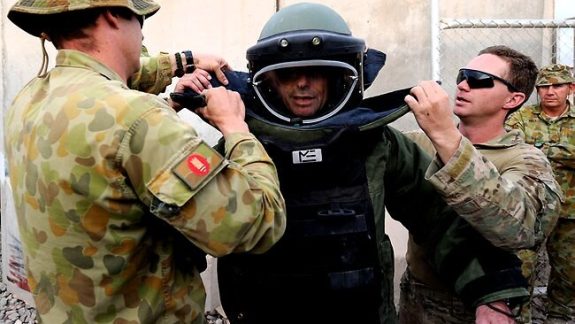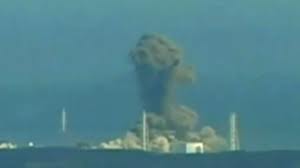The upgrading of Australia-Japan defence ties by the Abbott Government sends a dangerous and irresponsible signal to China, writes Dr Strobe Driver.
Bishop, Johnston and what the West helped teach China
The recent trip of Foreign Minister Bishop and Defence Minister Johnston to Japan in order to build greater ties via the articulation of defence needs, and talk intellectual/product/intelligence interchanges is a very dangerous stance for Australia to adopt. The level of this type of political intimacy would be okay if times were different, but they are not. What should be understood is that China is rising at an astonishing rate and whilst this process is taking place it is utilizing the pathway of postulation via threat-of-force. This is manifesting in what it believes to be a ‘reclaiming’ of its territories.
To be sure, China is only following the pathway that the United States (US) and the Soviet Union taught the world in the Cold War; and more recently what the US and its allies have consistently shown the world in the invasions of Vietnam, Iraq, Afghanistan (including ongoing US drone-strikes in the sovereign state of Pakistan) and with regard to the Soviets, Chechnya, the Ukraine, and to a lesser extent Georgia. France and its meddling in Indo-China and Algeria, Britain in Malaya and the Islas Malvinas/Falkland Islands have also succeeded in sending clear messages to China that invasion cum occupation are vibrant post-preponderance mechanisms.
From these examples there is no historical reason for China not to pursue its ambitions using preponderance through the prism of threat-of-force with an understanding that there will be a follow-up application of actual military force if need be—this in current circumstances would happen most likely by the geo-strategic stretch of the People’s Liberation Army Navy, and has been recently displayed in their recent intrusions further into the Pacific Ocean.
Australia – Japan and ‘defence’
The political movement of significantly closer Australia-Japan relations at this friction-filled time in the region is dangerous in the extreme for Australia. Why? First and foremost it sends a message to China that Australia will show allegiance to Japan militarily if there is a China-Japan ocean clash. One must ask if this were to occur what Australia could do about this in order to defend show its allegiance to Japan. The answer is ‘very little,’ beyond voicing its concerns in the United Nations (UN).
The unpalatable truth of the matter is Australia simply does not have the capabilities to facilitate a military response even if it wanted to, and with this in mind, what could Japan do if there was an Australia-China ocean clash in the region? Before an answer to this question is offered, it is timely to observe that as recently as the 11th June, 2014, a reference to the continuing frictions—which have a serious potential to drag Australia into a regional conflict—was brought up in a recent senate hearing.
Australian Defence Department head Dennis Richardson in an assessment of the instability in the region and the possibility of a unilateral action (read: China) destabilising the region, he stated in part “…there is always the risk of an accident or a miscalculation … ”.[1] What then would be the outcome and what could Japan do if a Royal Australian Navy (RAN) ship sustained damage, or was sunk in an exchange of fire? Japan could also do nothing, as it does not have ‘blue-water’ or ‘ocean-going’ navy capabilities to exercise any form of significant control beyond its littoral boundaries. In simpler terms, Japan possesses a ‘green water’ navy only. Moreover, and contributing to the non-interventionist strategies that would come to the fore is Japan’s neighbours have deep-rooted animosities toward it, and therefore to act in such a way would signify a resurfacing of its historical expansionist tendencies; and create a storm of protest from its near-neighbours. Hence, Japan would be very hesitant to act on behalf of another country, whether Australia or the US, due to its severe regional history.
Moreover, the sensitivity of its neighbours and the fact that such an action might trigger and then encourage China and Russia to act in a more definitive way on their territorial claims is the opening of a Pandora’s box that Japan simply does not want. Whether the territorial claims of China and Russia are valid is a moot point and beyond the scope of this essay, however the socio-psychological and geo-strategic intentions of Japan’s neighbours should not be underestimated as they play a significant role in Japan’ geo-political environment.
History and fear
To be sure, Japan’s other enormous fear, which one could suggest outstrips any other in terms of engaging in a conflict is its complete and absolute reliance on imported oil and this too, should not be underestimated. For instance, a concerted effort by China to limit and/or cut off supplies to Japan would place the Japanese economy in a parlous condition. Bearing in mind this is exactly what the US did in gaining the unconditional surrender of Japan in the Pacific phase of World War Two (WWII) is to acknowledge the issue remains alive in the island nation.
More to the point and an important part of the scenario of geo-strategies is to realise, in more contemporary times, the aspect of Japan’s reliance on imported oil can be observed in that, part of the reason the US invaded Iraq the second time in 2003 was to exercise a level of control over oil supply exports from the country. This had, and has, the ongoing residual of contributing to an ‘understanding’ by Japan that it is somewhat ‘tied’ to the US geo-strategically; discourages the questioning of the ongoing post-WWII positioning of US forces in Okinawa; and extrapolating on Jacques argument, encourages Japan to ‘think of itself as an Asia-Pacific power rather than [an] East Asian power’[2] and further highlights Japan’s post-Meiji stance of respect for the West and contempt for Asia.[3]
Nevertheless, where does this leave Australia if an ‘accident or a miscalculation’ were to take place and if these closer Australia-Japan military ties resulted in an RAN ship being damaged/sunk in an engagement? The default position of the Abbott government is that the US would immediately step in and come to the ‘defence’ of Australia—the ANZUS treaty notwithstanding. Relying on an assumption as the region becomes more friction-filled is dangerous in the extreme; and has the potential of placing Australia in a perilous position.
Essentially, Australia’s position is one of being involved in the region to the extent of overtly demonstrating an alliance with a distant neighbour that has no military response capabilities in terms of coming to Australia’s aid; and of assuming the US will respond immediately and precisely with a corresponding show of force is fragile. If Australia must take sides the Abbott Coalition and conservative government needs to seriously assess whether the US, in the next two decades, will exercise any form of robust response to Australia’s ‘needs’ in the Asia-Pacific (A-P) region. Moreover, it is an already acknowledged fact that America is a war-weary and “foreign policy fatigue[d]”[4] nation, whose people are perplexed by the lack of appreciation shown for its endeavours in saving and/or rescuing other nations (such as Afghanistan and Iraq), have the will to interdict in the A-P region, regardless of what their president states.
To believe this stance would change if Australian forces were threatened/destroyed is a fantasy.
To assume the US would intervene, if there were a force-on-force collision on the high seas, is a belief that has its roots in a time long gone. America will do what is best for America, and to assume otherwise befits an historic underpinning that is now superseded. Moreover this attitude displays in the Coalition a genuine lack of awareness of the coming state-of-affairs; and what the coming storm—consisting of a deliberate containment of China—will bring.
The historical situation remains transfixed in the minds-eye of this Coalition government (as it was the previous Labor government), by what the US accomplished in the ‘saving’ of Australia as the Japanese advanced through the A-P region in the (early) phase of the Pacific theatre in WWII. The US did come to Australia’s aid at this time and to be fair, after the bombing of Darwin Australian policy-makers had been caught completely off-guard by Japanese advances; and were in a state of disarray.
The here and now: how times have changed
The above-mentioned scenario, of Australia being caught by surprise and needing to have acute intervention is, in contemporary times, not applicable. In the late twentieth and the early twenty-first century the dissemination of information is much greater and the awareness, information and debate is robust in political, military and academic realms. There is a vast amount of information with regard to China’s rise and the possible trajectories, the threat it may pose, and the potential collisions that may occur—there are none of the ‘surprise factors’ that were present in 1941-42.
Therefore, to not understand or to blithely ignore the enmeshment of history and the severe implications it could have for Australia—or to continue on an ‘as normal’ pathway when dealing with Japan in the current state-of-affairs—borders on a wilfull denial of Japan’s history in the region; a the impact the rise of China will have on Australia from a military perspective; and harnesses a misguided belief that the regional power-stakes will not undergo seismic change in the near-future. Ministers Bishop and Johnston’s behaviour on behalf of the Abbott government signal a retreat to the sanctuary of the past in which the US—as it did in the early 1940s—will come to the aid of Australia immediately and completely; and that Japan will remain steadfast in its military allegiance to Australia as the pressures from China grow.
These are the gravest of mistakes and the positioning of Australia by Bishop and Johnston’s actions send a clear and overt signal to an up and coming regional strength that previous relationships matter at the expense of creating new and vibrant ones. Thus, the upgrading of Australia-Japan defence ties (even if the end result is one of only symbolism) sends a dangerous and irresponsible signal to a burgeoning China—a land of a sixth of the world’s population, and a country that has over a million-plus military personnel—and makes the coming era of pax-Sino for Australia an increasingly dangerous place, within a progressively fragile environment overall. Australia’s default should be one of striving for inclusiveness in all the A-P region, and not be one of sending exclusive signals to one country which might antagonise another.
It is timely here to consider the actual worth of US’ assurances, and reflect on the history of such ‘assurances’ in the ‘cold light of day.’ There were assurances given to the Southern Iraqi (Marsh) people during the latter stages of the First Persian Gulf War, the Army of the Republic of Vietnam (South Vietnamese Army) were also given assurances during the latter stages of the Vietnam War, the Hmong people of the Central Highlands of Vietnam were also given promises by the US government during the Vietnam War in their fight against the North Vietnamese.
In recent times Iraq was told the US would stay the course, and Afghanistan was told it would be helped until complete independence: all in one way or another were rescinded upon. For Australians’ to think they are of greater importance than any of the aforementioned is irrational; and unsupported by reality. Lastly, a perspective on the Americans’ coming to Australia’s rescue in the Pacific phase of WWII should also be given its place, if only to observe what could happen if the above-mentioned Australia-China collision comes to pass and the region explodes into a kinetic-phase of military action. American policy with regard to Australia at the time of WWII is able to be seen in its true light when Wurth’s recent book, 1942 Australia’s greatest Peril, is examined. Wurth states:
The security of Australia had just been listed very low on a secret US Army list of strategic priorities – in fact, behind seven other priorities -beginning with maintaining Britain, keeping Russia in the war as an enemy of Germany, and maintaining the status quo in India, the Middle East and China.[5]
Foreign Minister Bishop and Defence Minister Johnston should ask the US where Australia actually is placed in its current list of priorities, as one could (and should) based on history, doubt that it is at number one. Regardless of where Australia is on any foreign powers’ list, a more measured and articulate approach needs to be taken toward China in the A-P region. A more coherent and sensible approach to China is sorely needed, if only because China is now on a pathway to exercising preponderance with the addendum of force; that we are in no way assured of America’s response if a ‘miscalculation’ leads to conflict, regardless of our joint histories; and that Australia wishes to show China it is an independent, critical thinking nation, one capable of making its own way in the region free of American influence.
To go in the Bishop-Johnston direction on behalf of the Abbott government is tempting a future military fate; and Australians’ should further understand, time is running short to have a positive input in balancing the region before a war breaks out.
Footnotes:
[1] Mike Head. ‘Australian Senate committee discusses threat of US-China war.’
http://www.wsws.org/en/articles/2014/06/11/wars-j11.html?view=article_mobile
[2] Martin Jacques. When China Rules the World. London: Penguin Books, 2009, 400.
[3] When China Rules the World, 394
[4] Tom Switzer. ABC Lateline ‘Friday Forum.’ Presenter/Reporter: Emma Alberici http://www.abc.net.au/lateline/content/2014/s4025260.htm 13, June 2014.
[5] Bob Wurth. 1942 Australia’s greatest peril. Sydney: Macmillan Australia, 2008, 19. Italics and highlight mine.
This article was first published on Geo-Strategic Orbit and had been reproduced with permission.
More articles by Dr Strobe Driver:
What a State demands, what a citizen gives, and what Abbott and Hockey simply don’t understand
People ‘cost too much’: the Abbott Government and Neoliberalism
Like what we do at The AIMN?
You’ll like it even more knowing that your donation will help us to keep up the good fight.
Chuck in a few bucks and see just how far it goes!
Your contribution to help with the running costs of this site will be gratefully accepted.
You can donate through PayPal or credit card via the button below, or donate via bank transfer: BSB: 062500; A/c no: 10495969














